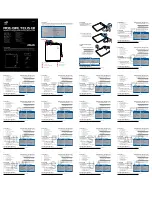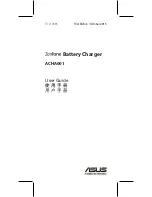
3. PREPARING TO CHARGE
1) Be sure area around battery is well ventilated while battery is being charged or maintained.
2) Clean battery terminals. Be careful to keep corrosion from coming in contact with eyes.
3) Add distilled water in each cell until battery acid reaches level specified by battery manufacturer ONLY AFTER the battery has been charged.
Adding water to a discharged battery may result in acid leaking out of the battery and causing injury to persons and damage to property. Do not
overfill. Study all battery manufacturers’ specific precautions; however, make sure to REPLACE ALL CELL CAPS after refilling so that water
evaporation is avoided. Water will evaporate over time if cell caps are not replaced after refilling. For a battery without removable cell caps,
such as valve regulated lead acid batteries, carefully follow manufacturer’s recharging instructions.
NOTE: The battery fluid level should be checked every 30 days
4) Study all battery manufacturers’ specific precautions while charging and recommended rates of charge.
4. DC CONNECTION PRECAUTIONS
1) The Minn Kota charger will only charge 12 volt 6 cell lead acid batteries. Do not connect the output of the charger to any other voltage or
type of battery.
2) The charger’s terminals are designed to be permanently mounted and connected to batteries.
3) The charger output leads must be connected with the correct polarity for the charger to function. The RED lead must be connected to the
POSITIVE terminal of the battery and the BLACK lead must be connected to the NEGATIVE terminal of the battery.
See section 5 under
“CONNECTING THE BATTERIES TO THE CHARGER” for proper connection procedure.
5. INSTALLING THE BATTERY CHARGER
CHARGING REQUIREMENTS:
In order to achive full output from the DC Alternator Charger, the minimum input from the engine alternator must be as follows:
MK-1-DC: 12 amp minimum
MK-2-DC: 25 amp minimum
MK-3-DC: 35 amp minimum
CHOOSING THE MOUNTING LOCATION:
Do not mount the charger above batteries as lead-acid batteries give off corrosive gasses which will damage the charger over time. Never allow
battery acid to drip on charger when reading electrolyte specific gravity or filling battery. Also, as with most electrical devices, do not mount the
charger below the waterline of the boat or directly adjacent to fuel tanks.
Each DC input and output cord is 6 feet long. Make sure that all DC cords can reach the batteries.
If the DC battery leads are not long enough, they should be brought to a terminal block and extended from the terminal block with 12 AWG (min-
imum) wire. A fuse holder should always remain within 7 inches of the battery terminals. The maximum extension length is 15 feet. You may
contact the Minn Kota Service Department with any questions.
Even though the Minn Kota charger is capable of operating in a high ambient temperature environment, a minimum of 6 inches of unobstructed
area should be allowed on all sides of the unit for proper air circulation and cooling. Proper cooling and circulation will allow the charger to oper-
ate at peak efficiency.
MOUNTING THE CHARGER:
Due to the pounding that boats routinely endure, take the time to securely mount the charger to prevent damage. Mounting with bolts, nuts, and
washers is preferable to mounting with screws. Use the largest diameter bolts possible, and use all four mounting holes.
CONNECTING THE BATTERIES TO THE CHARGER:
1.
Find the input cable labeled “STARTING” and connect POSITIVE (RED) wire to POSITIVE (+) or ungrounded terminal on the starting battery.
Then connect the NEGATIVE (BLACK) to the NEGATIVE (-) or grounded battery terminal on that battery.
2.
Find each output cable and connect POSITIVE (RED) wire to POSITIVE (+) or ungrounded terminal on the trolling battery. Then connect the
NEGATIVE (BLACK) to the NEGATIVE (-) or grounded battery terminal on that battery.
3.
Connect additional output cables to additional batteries as described in step 2.
3
CAUTION
- Before making any connections to batteries in a confined space (such as a battery compartment of a boat), open the door or hatch
of the compartment and allow it to air out for 15 minutes. This allows any gasses that have accumulated in the compartment to escape.



























